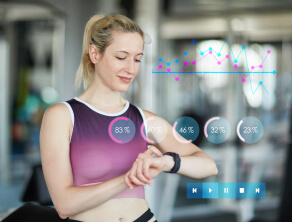Accelerating innovation in healthcare: How COVID19 is shaping digital transformation in the healthcare industry
Table of contents
- Introduction
- Healthcare in the pre-pandemic era
- COVID19: An accelerator for an overdue transformation in healthcare
- Innovative ways in which companies are fighting COVID-19
- Major technological highlights that proved effective in stressful times
- The healthcare industry’s transformation is likely to happen at full pace
- What will a post-pandemic healthcare landscape look like?
- Conclusion
Introduction
An effective digital transformation in healthcare has been long overdue. The overall adoption of digital tools for diagnosis, treatment, and hospital management has been just satisfactory. EMRs haven’t become a part of routine care yet, for instance. According to the Electronic Medical Record Adoption Model, the adoption of EMRs ranges from just 3 % in Europe to 35 % in the USA. The low adoption rate isn’t because of investments required or technical barriers expected, but primarily because of non-technological barriers, as per a report by McKinsey. Change of culture has been the biggest hurdle in the industry’s digital transformation. Three barriers to digital in the pharmaceutical and medical-technology industry were culture and mind-set, organizational structure, and governance. The onset of the pandemic, however, served as a black swan event that not only fast-tracked the adoption of digital technologies in healthcare but forced enterprises to overcome non-technological barriers as well in order to sustain themselves. These changes aren’t limited to the pandemic time alone, they are also creating defining moments that will shape the future of digital healthcare in the post-pandemic era as well.
Healthcare in the pre-pandemic era
Even before the pandemic, the healthcare industry was burdened with high demand, shortage of staff and inefficient workflows and processes. A report by the World Medical Association states that nearly half of the world’s physicians experience symptoms of physical, mental, and emotional exhaustion, confirming the significantly high levels of stress and burnout long before the onset of COVID-19. The only difference now is that there’s a need for greater efficiency and responsiveness more than ever before. While healthcare professionals have to deal with treatments and procedures for patients with critical ailments such as cancer, heart disease and other conditions on one hand, they have to continue to provide critical care support for COVID-19 patients as well. This creates an inevitable burden on the existing healthcare infrastructure as they need to juggle between these responsibilities.
To handle these responsibilities better, healthcare professionals must embrace new models of care delivery that are driven by digital technologies and are capable of adapting dynamically to rapidly changing conditions.
COVID19: An accelerator for an overdue transformation in healthcare
The COVID-19 crisis has brought about significant changes in healthcare systems all over the world- the major impact being its role in serving as an accelerating force for the digital transformation of the healthcare industry. Even as social distancing measures across the globe have started to ease, stakeholders are exploring digital solutions that can help to contain the current pandemic and its impact while also avoiding a second peak as much as they can. To that end, the industry is looking for ways that enable them to deliver effective and scalable healthcare while keeping people away from hospitals, surgeries and clinics wherever possible. In the next section, we’ll take a look at some ways companies worldwide have leveraged innovation in technology to handle the current crisis.
Innovative ways in which companies are fighting COVID-19
Companies globally are deploying proven technological solutions and developing new ones to boost innovation in healthcare and fight the coronavirus. Here are some exciting examples of it.
- 3D printed face shields and swabs using AI: An AI-based software company that also specializes in medical 3D printing to create anatomical models has leveraged their 3D capabilities to print face shields, ventilator parts and nasopharyngeal swabs. Following clinical trials, they have sent thousands of specially designed swabs to capture COVID-19 samples across the USA, Europe and Asia
- Real-time data and AI to create effective isolation monitoring: Wearable products often don’t provide information accurate enough to make critical clinical decisions. To resolve this problem, companies have leveraged Patient Status Engine (PSE) that automates the collection of raw patient data and decision-support tools for clinicians, by combining wearable sensors with wireless networks and big data to provide high-resolution patient monitoring and enables creation of high-dependency isolation wards rapidly.
- Monitoring social distancing using ultra-wideband (UWB) technology: a precision tracking product based UWB technology uses badges and watches to measure how closely and for how long individuals come into contact, by monitoring the time of flight of radio signals between devices. It also triggers alerts and real-time feedback via cloud platform to identify people at risk of COVID-19
- Detecting COVID19 via smartphone: An AI-based app uses light signal processing technology known (remote photoplethysmography or rPPG) through which a smartphone camera records light reflected by blood vessels beneath the skin. Since blood volume in micro-vascular tissue varies in response to respiration, blood pressure and other changes, the app converts this variation into measurements. It has been reported to be 90 % as accurate as hospital-grade monitors
- Cloud-based ventilation monitoring: A combination of patient data management software, and a cloud-based system, this solution consists of cellular chips in ventilation devices that send data which is then refined, sorted and made available to clinicians in an easy-to-read format, enabling quick monitoring and troubleshooting
Major technological highlights that proved effective in stressful times
As global healthcare faces unprecedented challenges due to the outbreak of the pandemic, technological solutions which have been in use for some time now became quite useful and their adoption has been increasing ever since. Digital tools such as videoconferencing, remote monitoring and data analysis are making a valuable contribution in handling the current situation and creating a positive shift that will further encourage their adoption in a post-pandemic era.
- Video calling solution for patients and staff: As the need for preventing new contaminations increases, it becomes essential for hospitals to have as little physical contact with each other as possible. At the same time, there is a need for accessible and quick communication right now. This significantly created a demand for video calling as a solution in the healthcare sector. We’re now seeing applications that enable video calling in healthcare being rolled-out at a faster pace. For instance, healthcare professionals who are put at home due to symptoms of the common cold aren’t allowed to physically go to work but are still able to function just fine by remotely assisting their colleagues with the help of video calling. Using videoconferencing, healthcare professionals can also maintain safe contact with patients who are in isolation in their homes
- Remote monitoring: With increasing numbers of infected patients, the shortage of beds in ICUs is also increasing. Hospitals are trying to double their capacities but such measures take time. Until then, patients can be treated outside of ICUs, say, in other wards, or at their home. This can be made possible with the help of remotely monitoring patients with the help of digital tools. Smart patches, for instance, allow remote monitoring of a patient’s vital signs, such as respiration, temperature and pulse. This greatly reduces the number of standard checks-ups and allows healthcare professionals to concentrate on people who require acute care. Additionally, remote monitoring also reduces the pressure on hospitals, allows patients to get treatment in the comfort of their own home, and serves as a preventive measure
- Data analytics and information provision: Big data and artificial intelligence are helpful in closely tracking the spread of COVID-19. Researchers can forecast how certain interventions could help manage the virus, and they are now exploring various scenarios. They also help to predict the number of expected infections, identify potential hotspots and much more. This information, when made available online, plays an important role in keeping citizens updated and cautioned
The healthcare industry’s transformation is likely to happen at full pace
The pandemic not only accelerated the adoption of digital technologies but also exposed the loopholes in the system that needs to be fixed. Here’s how a two-way acceleration is likely to fuel the transformation at a pace faster than before.
- The need to fix loopholes and vulnerabilities: The pandemic highlighted how workflows, processes and experiences in health care are inefficient. From the lack of access to accurate data from multiple sources that hindered care delivery, to several hospital leaders still using outdated technologies such as faxes to communicate with physicians and other hospitals, many opportunities to fix fragmented aspects of the industry have been identified. Healthcare leaders will now focus on areas such as care delivery, collaboration, and affordability.
- More adoption of data and technology: The pandemic will speed-up widespread adoption of data analytics and advanced digital technologies. The adoption of virtual health tools such as video calls and remote monitoring, which otherwise might have taken another few years to reach today’s levels, have already become the new normal. More data, interoperability, and analytics will also prove to be a significant breakthrough in utilization management, population health surveillance, and real-time data-sharing and communication.
What will a post-pandemic healthcare landscape look like?
The current scenario has already been a turning point in how stakeholders see digital technologies and innovation in healthcare. The non-technological barriers have been broken and the future of healthcare, at least for the next ten years, will be defined by three key aspects- consumer-centricity, data reliance, and new technologies.
- Consumer-centric: Prior to the pandemic and even more during it, consumers have become more conscious about their healthcare choices. They also demand data access and more transparency at each stage of their decision-making. This has made it essential for the healthcare industry to become more consumer-centric. In the past, we have seen consumers taking more time in making decisions due to the lack of transparency in healthcare- both about the costs and the value of services in improving their health. This has resulted in a waste of time and money, poor health and ineffective outcomes. Today’s consumers use personal technologies to measure fitness. According to the Deloitte 2020 consumer health survey in the next 10 years, consumers will have access to more accurate information that can promote informed decision-making and lead to better health outcomes.
- Value-based care and affordable: The value of a service depends on two factors- more quality or reduced cost. Currently, value-based healthcare services focus more on cost reduction and not on the quality of outcomes. As value-based healthcare models evolve, we’ll see stakeholders demanding higher quality alongside affordability. It is expected that in the next few years, payment models will become more outcome-centered, and there will be increased transparency and availability of data related to health system performance to validate outcomes.
- Pervasive use of advanced technologies and analytics: Earlier, the evolution of healthcare was centered around an infrastructure of buildings, people, assets, and products. In the current times, and in the times to come, the evolution will be focused more on an infrastructure model that is focused on data, platforms, interoperability and digital solutions. A modern infrastructure thus created, can enable the long-pending shift to accessible, affordable, quality health care.
Conclusion
The healthcare sector is currently facing one of the greatest challenges so far. It would be right to say that the pandemic is more than a black swan event. The global healthcare infrastructure was never fully equipped to treat people and save lives at a scale required today. This has made the need for more effective, scalable and resilient healthcare infrastructure a priority for healthcare leaders now. Despite the adversities caused by the pandemic, the healthcare sector is now presented with a powerful opportunity to innovate at a quicker pace and reinvent itself. Organizations that will use these opportunities to transform themselves will likely evolve into more scalable and resilient organizations. Stakeholders have gained valuable insights with respect to the importance of innovation and realized how technology can help keep healthcare safe, accessible and affordable. It has become quite evident how digital transformation, driven by the need of the hour, is revolutionizing the healthcare industry, the impact of which will redefine the landscape of healthcare entirely.
![Blog-[x]cube LABS](https://d6fiz9tmzg8gn.cloudfront.net/wp-content/uploads/2016/06/blog_banner.jpg)








